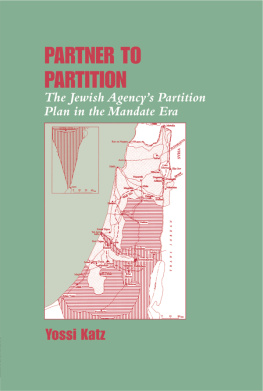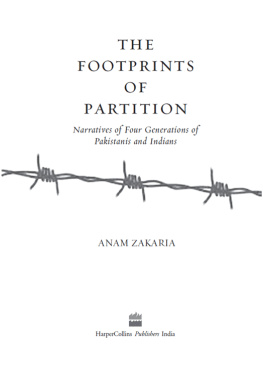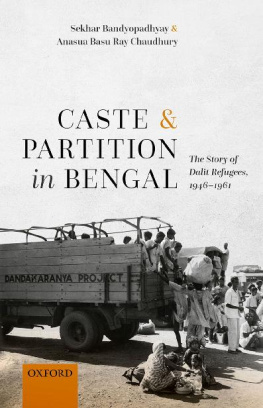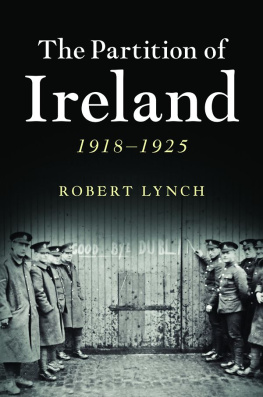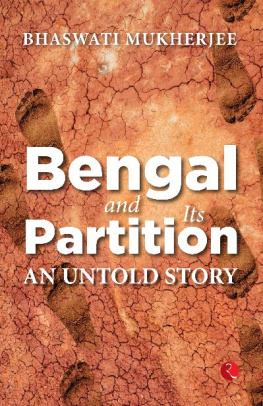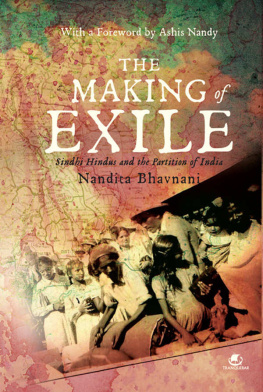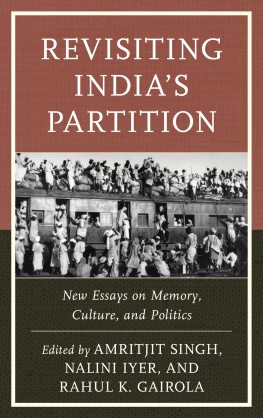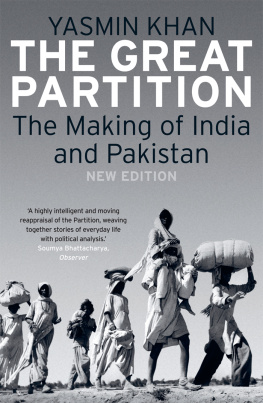Partitions Legacies by Joya Chatterji was first published by Permanent Black D-28 Oxford Apts, 11 IP Extension, Delhi 110092 INDIA, for the territory of SOUTH ASIA. First SUNY Press edition 2021.
Not for sale in South Asia
Cover design by Anuradha Roy.
Cover image: F. P. Mainprice and his wife at a Pakistan border post, 1950s. Reproduced courtesy of the Cambridge South Asia Archive, Mainprice Collection.
Published by State University of New York Press, Albany
2019 Joya Chatterji
All rights reserved
Printed in the United States of America
No part of this book may be used or reproduced in any manner whatsoever without written permission. No part of this book may be stored in a retrieval system or transmitted in any form or by any means including electronic, electrostatic, magnetic tape, mechanical, photocopying, recording, or otherwise without the prior permission in writing of the publisher.
For information, contact State University of New York Press, Albany, NY
www.sunypress.edu
Library of Congress Cataloging-in-Publication Data
Names: Chatterji, Joya, author
Title: Partitions legacies / Joya Chatterji, author.
Description: Albany : State University of New York Press, [2019] | Includes bibliographical references and index.
Identifiers: ISBN 9781438483337 (hardcover : alk. paper) | ISBN 9781438483351 (e-book)
Further information is available at the Library of Congress.
10 9 8 7 6 5 4 3 2 1
Preface
W RITING A PREFACE FOR a collection of essays written over almost thirty years presents a challenge of a different order to cobbling together a preface for a book. It requires one to think back over ones entire scholarly life and the directions in which it has evolved. A daunting task. I feel a bit like Winnie the Pooh: lets begin by taking a smallish nap.
Or maybe Ill begin at the beginning, with Mrs Khanna at Welham Girls School. I must have been about eleven when Mrs Khanna read us a primary source, the first I had ever encountered: Ziauddin Baranis Fatw-i Jahndr (Mirrors for Princes), written in the mid-fourteenth century. It took my breath away. She was a small and serious woman who read quietly, but the words struck me so powerfully that they have stayed with me ever since. It was perhaps from this moment that I was starting to try to become a historian by reading every historical work or novel I could lay my hands on.
But there was a problem. My father, who came from a respectable bhadralok family, thought that his academically minded daughter should become a doctor. In his own way he was a feminist and wanted me to become financially independent; he saw medicine as the route. I loved the sciences, but not as much as History. My first rebellion came when I was eighteen and joined Delhis Lady Sri Ram College to read History. Next I went to Trinity College, Cambridge, where I read more History and took a PhD in History on Hindu communalism in Bengal. A book followed shortly after, Bengal Divided (in the old century we were encouraged to publish our PhD theses quickly. I try to persuade my doctoral students to do the same now, to no avail.) My son Kartik was a somewhat manageable three-year-old by then, leaving the question of what to do next.
My essay writing began as a young mother whose periods of work were constrained. Three or four hours in the archives were all that I could find. Visits to Calcutta were a great to-do. I would set off with Kartik on my hip from my home in Delhi to my research locations in West Bengal, for a month or six weeks at a stretch. By this time I was a Junior Research Fellow at Trinity College, so funding was not an issue. Logistics were. I stayed for long periods with friends and family who looked after Kartik while I worked in archives or wandered through graveyards (no necrophilia, only fieldwork) during the day. In the evenings there would be the pleasure of a shower that washed the dust and cobwebs of the archives out of my hair, and a quiet hour with the children while anticipating a dinner of fish curry and rice. Heaven in a nutshell. Not everyones idea of heaven, to be sure: the Statesman archives at the time were at the top of the stately building in a lean-to with an asbestos roof. No fans allowed the papers were crumbling. The Special Branch Archives had no ladies loo. In the monsoon, Lord Sinha Road flooded and one waded through filthy water in Bata rubber chappals to get to the police archives. This was my perverse idea of bliss.
To begin with, I was feeling my way towards a new subject and found much in the archives that excited me. There was copious material on boundary-making, on refugees, on the surveillance of Muslims. I began to see fascinating patterns emerge. After a chat with Anil Seal, my former supervisor, I decided to follow his advice and write this material up as articles.
An article on the frontier emerged in this way. In 2000 or so, when Suvir Kaul asked me to contribute to a volume on the afterlife of Partition, I had enough notebooks on refugees to produce Rights or Charity. (This was in the analogue age.) When Mushirul Hasan and Asim Roy asked me to think about a volume they were putting together on the theme of Living together Separately, I had trudged through many of Calcuttas Muslim graveyards and read enough about Muslim flight and internal migration to write On Graveyards and Ghettos. These articles went down well, and, judging by feedback and footnote citations, seemed quite influential, being seen as asking new questions and providing at least half-decent answers.
A few years down the line I began to see the connections between these essays and they formed the backbone to my next book, The Spoils of Partition (2007). In my head the relationship between articles and books has been quite intimate. After an article is done and dusted I feel a pressure to take the story forward, to find out more, to provide a larger context and an overarching argument within which its ideas eventually come to nestle. In this sense I am not an essayist like, for instance, David Washbrook or Sumit Sarkar, both historians who frequently deploy the genre to solve and resolve questions in long autonomous essays of great depth and importance, and then move on.
Given that the essay is a form which, in retrospect, I seem to have treated as a starting point for longer explorations, I think I have, in order to provide each of my essays with a semblance of wholeness, played about a bit with structure, particularly when starting out. In The Fashioning of a Frontier I imagined the shape of an onion, peeling off layer by layer until I got to the core. (That was fun.) In Dispersal and the Failure of Rehabilitation I sometimes thought of my structure as an hourglass or sand timer, wide at the top with a narrowly focussed centre, widening out again into a broad base. The image sedimented the notion in my head that my academic essays might begin with a range of ideas which should concentrate on a case study and then flow out into a broad set of expandable conclusions both in my own books and in those by other scholars. With Migration Myths and the Mechanics of Assimilation I saw symmetry between apparently dissimilar texts, mirror images with their paradox of sameness and unfamiliarity. I think quite visually, I suppose, now that I come to reflect upon it, and my hope is that these formative images helped make my essays more elegant.


